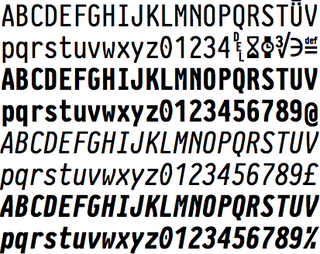Related Research Articles

Bitstream Cyberbit is a commercial serif Unicode font designed by Bitstream Inc. It is freeware for non-commercial uses. It was one of the first widely available fonts to support a large portion of the Unicode repertoire.
Unicode has subscripted and superscripted versions of a number of characters including a full set of Arabic numerals. These characters allow any polynomial, chemical and certain other equations to be represented in plain text without using any form of markup like HTML or TeX.
New Gulim (새굴림/SaeGulRim) is a sans-serif type Unicode font designed especially for the Korean-language script, designed by HanYang System Co., Limited. It is an expanded version of Hanyang Gulrim.
Unicode supports several phonetic scripts and notations through its existing scripts and the addition of extra blocks with phonetic characters. These phonetic characters are derived from an existing script, usually Latin, Greek or Cyrillic. Apart from the International Phonetic Alphabet (IPA), extensions to the IPA and obsolete and nonstandard IPA symbols, these blocks also contain characters from the Uralic Phonetic Alphabet and the Americanist Phonetic Alphabet.
In computing, a Unicode symbol is a Unicode character which is not part of a script used to write a natural language, but is nonetheless available for use as part of a text.

GNU FreeFont is a family of free OpenType, TrueType and WOFF vector fonts, implementing as much of the Universal Character Set (UCS) as possible, aside from the very large CJK Asian character set. The project was initiated in 2002 by Primož Peterlin and is now maintained by Steve White.
In Unicode and the UCS, a compatibility character is a character that is encoded solely to maintain round-trip convertibility with other, often older, standards. As the Unicode Glossary says:
A character that would not have been encoded except for compatibility and round-trip convertibility with other standards
In the Unicode standard, a plane is a contiguous group of 65,536 (216) code points. There are 17 planes, identified by the numbers 0 to 16, which corresponds with the possible values 00–1016 of the first two positions in six position hexadecimal format (U+hhhhhh). Plane 0 is the Basic Multilingual Plane (BMP), which contains most commonly used characters. The higher planes 1 through 16 are called "supplementary planes". The last code point in Unicode is the last code point in plane 16, U+10FFFF. As of Unicode version 15.1, five of the planes have assigned code points (characters), and seven are named.
The ISO basic Latin alphabet is an international standard for a Latin-script alphabet that consists of two sets of 26 letters, codified in various national and international standards and used widely in international communication. They are the same letters that comprise the current English alphabet. Since medieval times, they are also the same letters of the modern Latin alphabet. The order is also important for sorting words into alphabetical order.
Unicode contains a number of characters that represent various cultural, political, and religious symbols. Most, but not all, of these symbols are in the Miscellaneous Symbols block.
Enclosed Alphanumeric Supplement is a Unicode block consisting of Latin alphabet characters and Arabic numerals enclosed in circles, ovals or boxes, used for a variety of purposes. It is encoded in the range U+1F100–U+1F1FF in the Supplementary Multilingual Plane.
A variant form is a different glyph for a character, encoded in Unicode through the mechanism of variation sequences: sequences in Unicode that consist of a base character followed by a variation selector character.
CJK Compatibility is a Unicode block containing square symbols encoded for compatibility with East Asian character sets. In Unicode 1.0, it was divided into two blocks, named CJK Squared Words (U+3300–U+337F) and CJK Squared Abbreviations (U+3380–U+33FF).

PragmataPro is a monospaced font family designed for programming, created by Fabrizio Schiavi. It is a narrow programming font designed for legibility. The font implements Unicode characters, including (polytonic) Greek, Cyrillic, Arabic, Hebrew and the APL codepoints. The font specifically implements ligatures for programming, such as multiple-character operators. The characters are hinted by hand.
The Vietnamese language is written with a Latin script with diacritics which requires several accommodations when typing on phone or computers. Software-based systems are a form of writing Vietnamese on phones or computers with software that can be installed on the device or from third-party software such as UniKey. Telex is the oldest input method devised to encode the Vietnamese language with its tones. Other input methods may also include VNI and VIQR. VNI input method is not to be confused with VNI code page.
A number of Greek letters, variants, digits, and other symbols are supported by the Unicode character encoding standard.
References
- ↑ Everson, Michael; Dicklberger, Alois; Pentzlin, Karl; Wandl-Vogt, Eveline (2011-06-02). "Revised proposal to encode "Teuthonista" phonetic characters in the UCS" (PDF).
- ↑ "Scripts-15.1.0.txt". Unicode Consortium. 2023-07-28. Retrieved 2023-09-12.